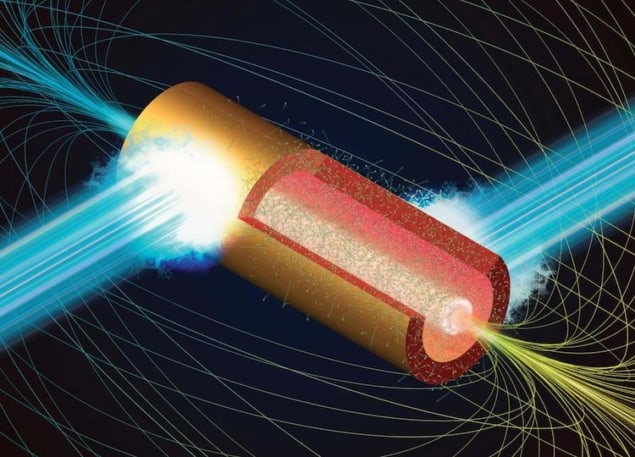
A newly discovered mechanism known as microtube implosion could make it possible to generate magnetic fields 1000 times stronger than any yet seen in the laboratory. According to the researchers who developed it at Japan’s Osaka University, the new method could be used to generate super-strong magnetic fields for fundamental research in fields such as materials science, quantum electrodynamics and astrophysics.
To date, the strongest magnetic fields produced in the laboratory have been in the kilotesla (kT) range. This is far stronger than the magnetic field of the Earth, which is 0.3–0.5 × 10–4 T, and substantially exceeds the fields produced in magnetic tomography (MRI) machines (about 1 T). While fields in this lower range are important experimental tools, stronger fields could make it possible to study fundamental physics phenomena in areas such as plasma and beam physics, astrophysics and solar physics. Researchers are therefore exploring various ways of producing such super-strength fields – including collisional shocks, gamma rays and fusion in strongly magnetized plasmas, as well as explosives, high-power lasers and devices known as z-pinches, which have been used for decades by astronomers to recreate the hot plasmas that exist inside stars.
Magnetic fields generated by spin currents
Most of these approaches begin by taking the magnetic flux from “pre-seeded” strong magnetic fields and attempting to confine it within hollow cylindrical structures. A team led by Masakatsu Murakami has now used a similar physical configuration, but with a twist: the ultrahigh magnetic fields in its microtube implosion technique are generated by the spin currents created as charged particles are spun around by the Lorentz force, which acts on moving charged particles in a magnetic field.
In their work, the researchers simulated using high-intensity laser pulses of around 1020–1022 W/cm2 to irradiate a micron-sized plastic tube lined with a structured “target” material. This intense radiation produces “hot” electrons (that is, electrons with a lot of kinetic energy) that have temperatures equivalent to a few tens of mega-electron volts (MeV). These high-energy electrons cause the target material in the tube to ionize, producing a plasma that subsequently expands into the tube at near-relativistic speeds (the implosion).
In an idealized configuration with no pre-seeded magnetic fields present, this procedure will not generate strong magnetic fields. However, the researchers found that if they introduced a kilotesla-order magnetic field into their simulated system, they could generate an “extraordinary” magnetic field at the centre of the microtube that is 100–1000 times stronger than the pre-seeded field. Such strong magnetic fields are expected only in celestial bodies like neutron stars and black holes, Murakami says.
Proof-of-principle experiment
So what is happening? Murakami explains that during the implosion, the Lorentz force deflects the ions and electrons in the plasma in opposite directions so that they become twisted – an effect known as Larmor gyration. The resultant collective motion of the relativistic charge particles around the central axis of the microtube produces strong spin currents with densities of around 1015 ampere/cm2. These spin currents, he says, are what subsequently generate megatesla-order magnetic fields in the centre of the tube.

Indoor record for magnetic field strength is smashed by physicists in Japan
“Our new study, detailed in Scientific Reports, is a proof-of-principle that current laser technology can be used to create megatesla-sized magnetic fields,” Murakami tells Physics World. “We now plan to investigate high-energy-density physics such as particle acceleration, developing compact fusion devices and electron-positron pair creation using the new concept of microtube implosion.”



